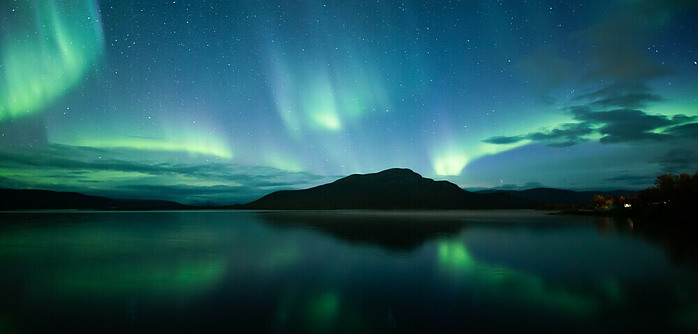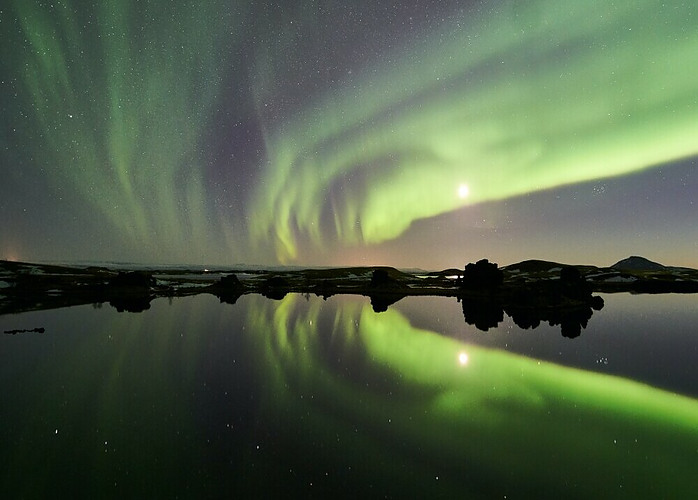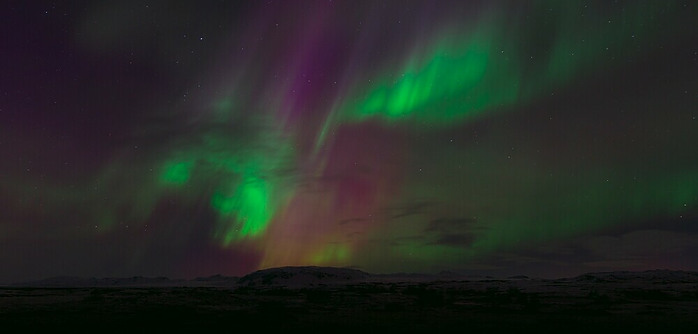Sami Matias. (2019) the Northern Lights [Photograph]. Unsplash.
Imagine standing under a vast night sky; the darkness around you suddenly alights with an ethereal dance of colors. That’s the Northern Lights, or Aurora Borealis, nature’s celestial display. This phenomenon is not just a visual feast; it’s a natural marvel that has fascinated humans for centuries.
So, what colors are in the Aurora Borealis? The answer lies in a complex interaction between solar particles from the sun and the Earth’s magnetic field and atmosphere. As these particles collide with atmospheric gases, they create a glow that can be seen from the ground—an aurora.
The colors you witness while gazing up at this spectacle aren’t random; they hold specific meanings and stem from the types of gas particles and their altitude. In this article, I will uncover the reasons behind the various hues you might see and the emotions they evoke.
This journey into the world of the Northern Lights will start by exploring the myriad colors that paint the polar skies. Next up: understanding the aurora’s color spectrum and the science that creates this stunning natural phenomenon.
Unlocking the Spectrum of Aurora Colors Explained
Kuku Campers. (2023) The Northern Lights [Photograph]. Unsplash.
When I look up at the night sky to witness the Northern Lights, I see a canvas painted with spectacular colors. You’re seeing the results of collisions between charged particles released from the sun and gaseous particles in the Earth’s atmosphere. Different gases interacting with these solar particles produce various hues, which offer far more insight than just an artful display.
- Oxygen, at about 60 miles above the Earth, is mainly responsible for the aurora’s standard green and yellowish-green colors, a reaction occurring when these particles collide. At higher altitudes, say 200 miles or more, oxygen provides red, a less frequent visitor to the auroral stage due to its dependence on higher-energy particles.
- Nitrogen, another principal player, dances in blue and purple hues. Yet, blue often gets outshone by the brighter green; it’s a subtle but mesmerizing member of the aurora family. Pink and violet hues emerge when nitrogen is excited at different energy levels.
The colors can also indicate the type of solar wind conditions at the time of the display. For instance, a high-intensity solar event could occur if I observe an aurora with a pronounced red at lower altitudes. Green shows more moderate solar activity. So, these heavenly hues serve not just to enchant us but also as a gauge for the energy delivered from solar events.
Green – The Emblematic Hue of the Aurora Borealis
Martin Brechtl. (2019) the Northern Lights [Photograph]. Unsplash.
When I think of the Northern Lights, green auroras are the color that often springs to mind. It’s the hue that paints the night sky most frequently, and there’s a scientific reason for this prevalence. The green auroras result from solar particles interacting with oxygen molecules in the Earth’s atmosphere at altitudes of around 100 kilometers. This interaction excites the oxygen, leading to that spectacular green glow.
But the allure of this color goes beyond its visual beauty. We humans often draw profound connections between natural phenomena and our cultural tales. In various societies, green auroras have embodied everything from harbingers of good fortune to the spirits of the deceased. In some Nordic cultures, for instance, a green aurora was once believed to signal a bountiful harvest, aligning with ideas of growth and rejuvenation associated with greenery.
Green auroras can elicit a deep emotional response from those lucky to witness them. Their brilliance and majesty have been known to turn even the most casual observer into a dreamy-eyed nature enthusiast. There seems to be an almost mystical pull that encourages us to stop and reflect on our place within this vast universe.
This section segues neatly into the topic of less common aurora colors, such as blues, reds, and purples, which, although not as frequent, have unique stories to tell.
Beyond Green: Interpreting the Rarer Colors of the Night Sky
Anders Jilden. (2015) the Northern Lights [Photograph]. Unsplash.
Beyond Green: Understanding the Rarer Northern Lights Colors
While green might take center stage in the Northern Lights, the celestial ballet occasionally adorns itself in rarer colors like blue, red, and violet. These hues are infrequent guests in the night sky, and their appearances are linked to specific conditions high above the Earth’s surface.
- Blue auroras result from nitrogen molecules getting energized at lower altitudes. Although blue is a serene spectacle, it’s shy, typically seen at the lower edges of the green auroral curtain.
- Red auroras paint the sky with a fiery brush. Emitted at the highest altitudes, these red lights signal high-energy particles and are more often seen during intense solar storms.
- Violet and pink tones emerge in a delicate dance, a visual symphony orchestrated by a more substantial solar presence. These colors manifest when increased solar activity amplifies the excitement of atomic and molecular nitrogen.
Watching these colors isn’t just a feast for the eyes; it’s a lesson in solar-terrestrial interactions. The colors of the Northern Lights serve as a real-time canvas displaying the ebb and flow of solar energy interacting with Earth’s atmosphere.
Remember that patience is vital as we transition to the best ways to witness this magnificent display. Chasing the lights means being prepared for the unpredictable nature of these cosmic performances.
Experiencing the Aurora: Best Practices and Tips for Observers
Jonatan Pie. (2017) the Northern Lights [Photograph]. Unsplash.
A spectacle like the Northern Lights warrants more than a superficial glance; it calls for a thoughtful encounter. I aim to share actionable guidance that can transform your viewing from an ordinary event to a memorable experience.
- When to See the Aurora: Winter months offer longer nights and thus more opportunities but don’t overlook the equinoxes, when solar activity can be pronounced.
- Best Locations: Remote areas away from city lights are your best bet—think northern latitudes with minimal light pollution.
- Safety Tips: Dress warmly, let someone know your whereabouts, and stay aware of local wildlife and terrain hazards.
- Photography vs. Enjoying the Moment: While capturing the Northern Lights on camera can be rewarding, remember to take a moment to enjoy the display with your own eyes. The raw emotion of seeing the colors dance across the sky is fleeting.
As you gaze upon the vibrant tapestry above, consider the meaning of the aurora colors and the science behind each color’s appearance. Each hue tells a story of interactions far above us, a reminder of the planet’s place in the wider cosmos.
Finally, keep expectations realistic. The northern light colors are elusive, and their brilliance doesn’t always match the photos. Yet, this unpredictability makes witnessing them even more magical. If you’re lucky enough to catch the aurora, let its colors inspire a sense of wonder and appreciation for the natural world.
By arming yourself with knowledge and approaching the experience with preparation and patience, you stand a good chance of enjoying one of Earth’s most awe-inspiring natural phenomena. Good luck, and stay warm out there!
Disclaimer: The Northern Lights is a natural phenomenon, and sightings cannot be guaranteed.
For additional blogs, please visit: https://northernlightsshuttertech.com/
(This post contains affiliate links. If you make a purchase, I may receive a small commission at no cost to you )






